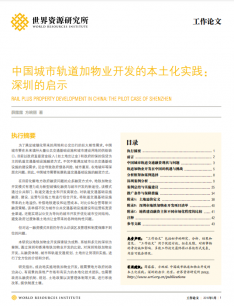Rail Plus Property Development in China: the Pilot Case of Shenzhen
This paper explores a contextualized Rail plus Property Development (R+P) model in China, a sustainable urban rail financing approach that has the potential to wean Chinese cities away from the current ill financing practices of land leasing and foster more efficient urban forms. Based on the critical investigation of Shenzhen, the early adopter of the R+P Development in the mainland China, the paper distills recommendations for Chinese cities to replicate R+P Development at scale.

Mounting housing and travel demands fueled by the rapid urbanization in China have created hug transit infrastructure gaps. However, the lumpy land lease payment and governmental borrowing through special purpose vehicles as the major source of transit funding, have not only aggravated municipal financial liabilities, but also led to boarder adverse impacts such as urban sprawl and farmland depletion.
On the other hand, ample opportunities exist to capture land value increments around transit station as new alternatives to finance transit systems. In China, although the land premiums accrued from the improved accessibility of transit services abound, they have been mostly captured by real estate developers.
To finance transit infrastructure through land value capture, Hong Kong’s Rail plus Property Development—a mechanism that leverage public-private-partnerships to create and capture land premiums—provides more relevant and plausible solution. Although in China, a growing number of cities, such as Shenzhen and Hangzhou, have spearheaded Rail plus Property Development, the widespread adoption of this model is still hampered by conceptual misunderstandings, institutional and regulatory barriers, lack of financial incentives, and capacity constraints.
Based on the in-depth understanding of the current barriers with Rail plus Property Development, the study investigates the experiences of Shenzhen, a coastal first-tier city of China, where Rail plus Property Development was implemented on a full scale with success. Building on extensive expert interviews, field visit`s, and comparative case studies between Shenzhen and Hong Kong, the study analyzes the policy innovations. The study further explores Shenzhen’s scalability and generates universal recommendations to other cities that might face similar problems.
Specifically, the study provides the following recommendations for local governments to set up financial arrangement to initiate Rail plus Property Development projects:
- Government’s financial contribution to fund urban transit projects take various forms (general budget expenditure, land use rights, or private public partnership), rail plus property development is not necessarily the only solution;
- Land contributions that government made to Rail plus Proper Development should ensure the projects’ rates of return and the overall social-environmental benefits;
- Rail plus Property Development is a risky undertaking; the early identification of macro-economic and institutional risks and the establishment of clear and fair rules for cost-, benefit-, and risk- sharing among stakeholders are vital;
- Performance-based contracts and government oversights are necessary to improve city-owned transit agencies’ operation efficiency and promote them to be entrepreneurial.
The study also underscores that the formula of Shenzhen’s success does not rest on any single factor, but rather integrated approaches. For Chinese cities to implement Rail plus Property Development, profound reforms need to be implemented in the following areas:
- To legalize governments’ in-kind land contributions to Rail plus Property Development pilot projects can streamline project implementation and mitigate institutional risks;
- Sound planning principles are important to create land values and guarantee the broader socio-environmental benefits:
- Cities need to incorporate transit-oriented development in urban master and regulatory plans;
- Zoning codes around transit stations should be flexible to meet changing market demands;
- Multi-stakeholder participation is crucial to strike a balance among vested interests of R+P development.
- Cross-departmental coordination is necessary to streamline decision-making and implementation;
- Local legal and regulatory reforms to operationalize stratified air rights and mix land uses near transit stations are useful to overcome institutional uncertainties.
- Cities need to grow in-house expertise on the management and operations of Rail plus Property Development, and acquire professional consulting services to jump start;
- Nation-wide capacity building and standard toolkit development are necessary to bridge the knowledge gap.